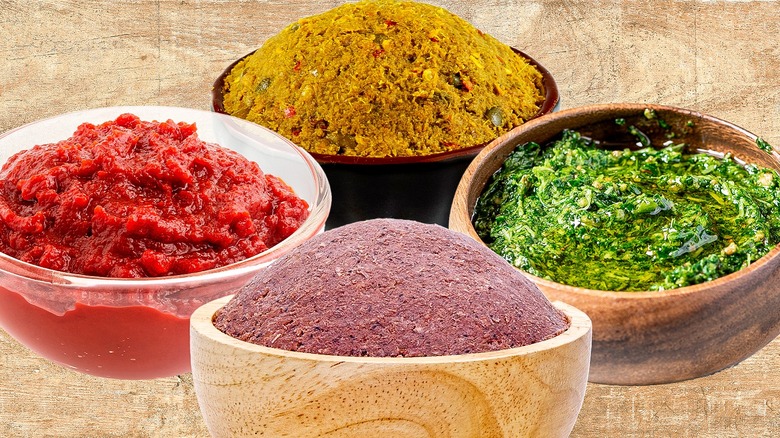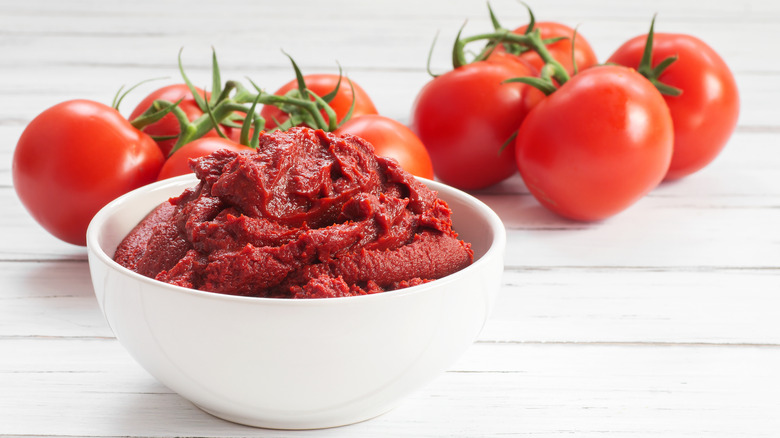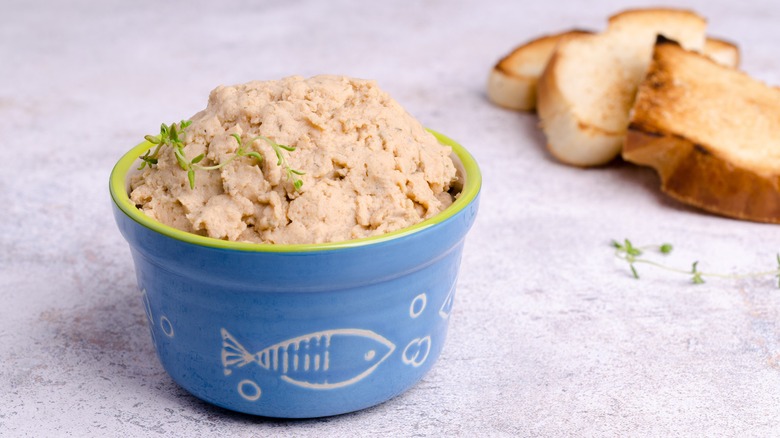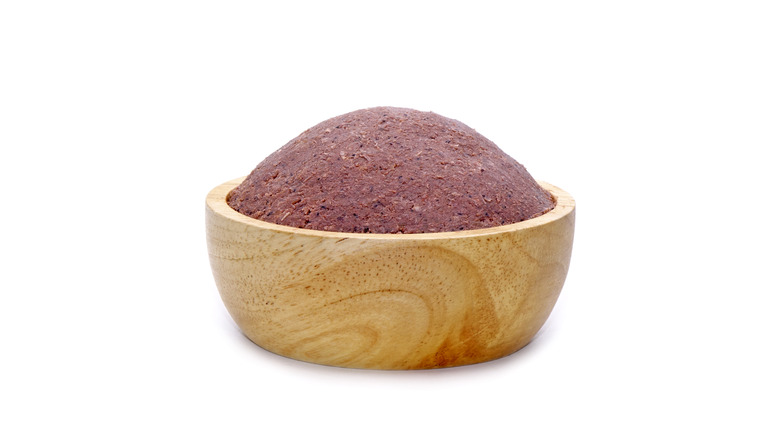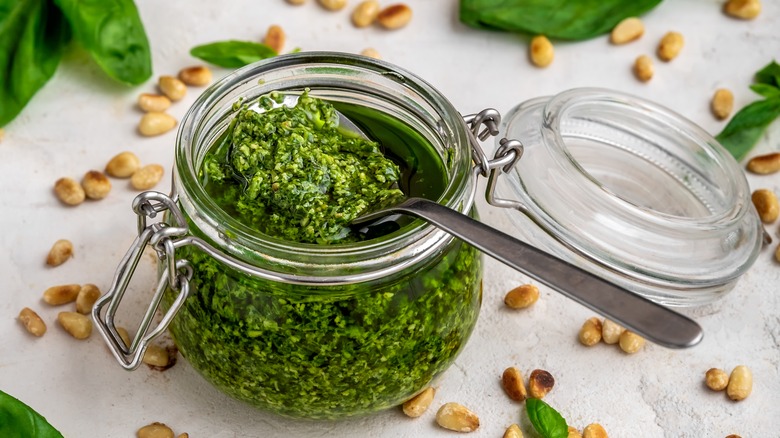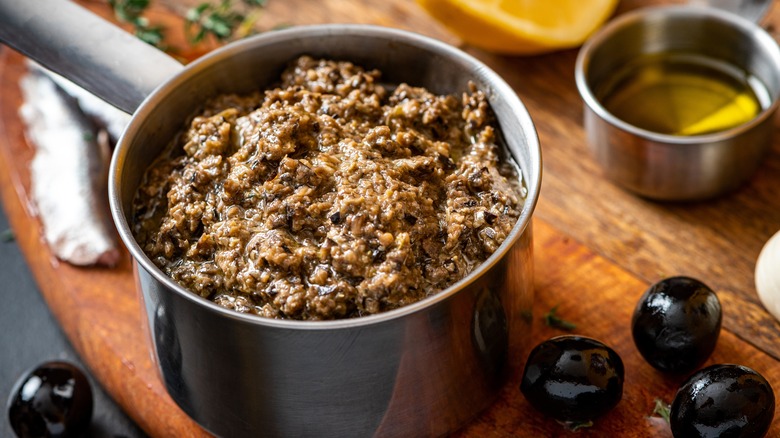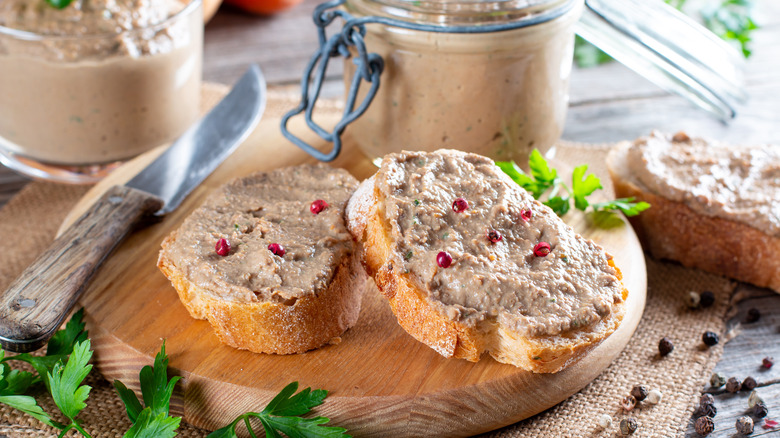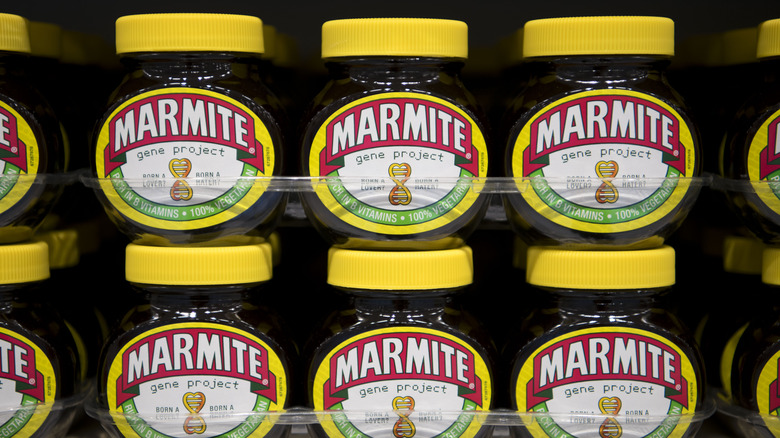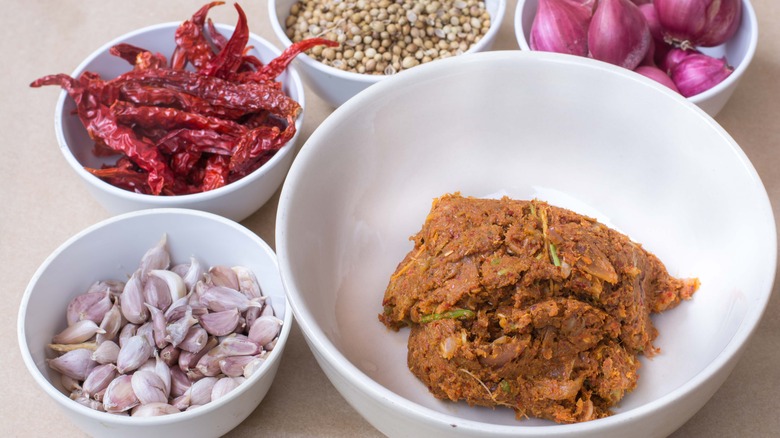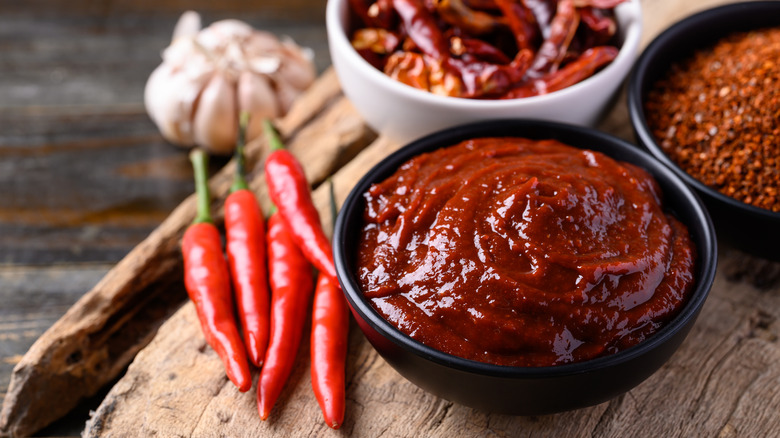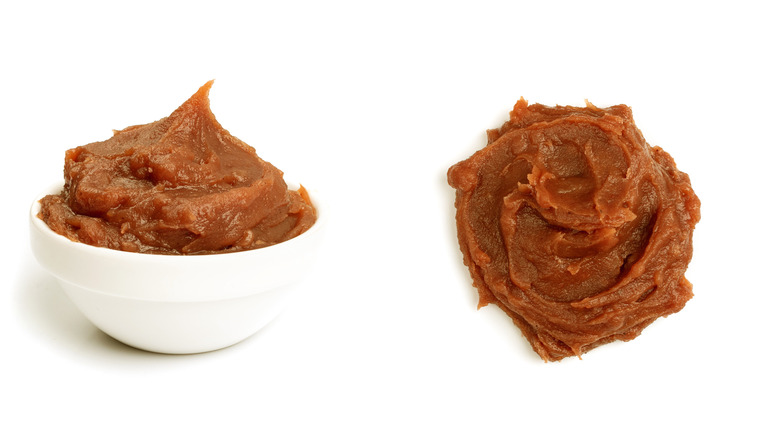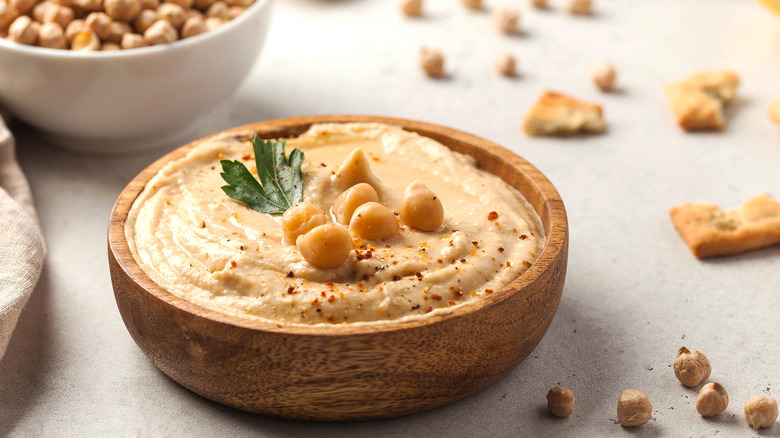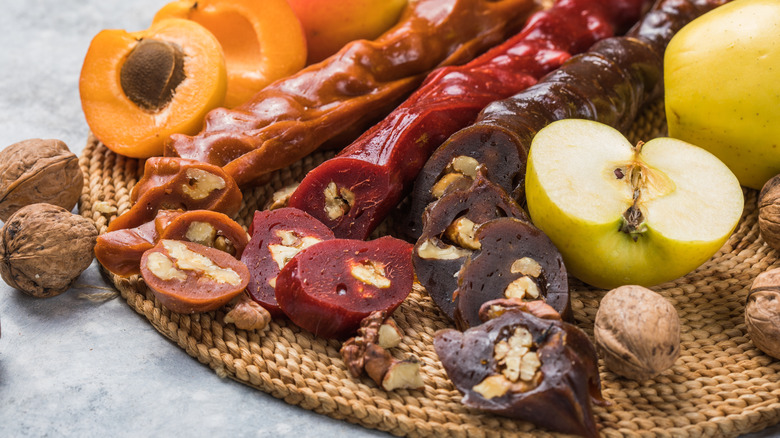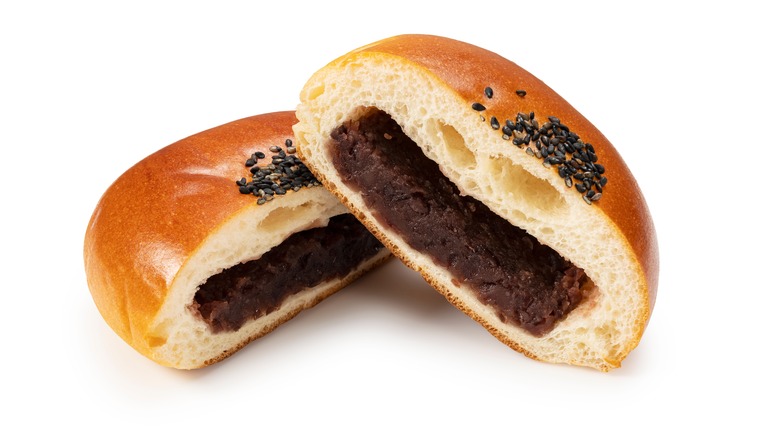14 Types Of Cooking Pastes, Explained
Around the world, there's a dizzying variety of pastes used in cooking: sweet, salty and savory, cooked and raw, meat-based and plant-based, fermented and unfermented, just to name a few. Mashing or grinding ingredients into paste might be one of humanity's oldest cooking techniques when you consider that the mortar and pestle is one of our earliest cooking tools, used for at least 100,000 years.
Many types of food paste are still made with mortar and pestle today, using variations like the Mexican molcajete, made from rough volcanic stone, or the Japanese suribachi, with ridges built into its ceramic bowl to grind delicate ingredients. This technique can produce different flavor results than other preparation methods. For example, mashing garlic releases more of its essential oils than chopping, resulting in a more intense garlicky flavor. Other food pastes are made with modern implements like blenders, and others are actually concentrates, made by cooking down liquids into semisolids. However they're made, pastes are an essential part of many cuisines. Here's the lowdown on food pastes across the culinary world, what they are, and how you can use them yourself.
Tomato paste
Tomato paste is an example of a concentrate. It's made by blending cooked tomatoes, straining out the skins and seeds, and cooking the liquid further until most of the water has evaporated. Packed with flavor, the resulting paste is sold in cans or tubes and may contain added salt, sugar, or preservatives, depending on the brand. Italian and American tomato paste manufacturers use different industrial production methods that produce different results. Compared with American tomato paste, Italian tomato paste is looser in texture, with a brighter color and a fresher taste because it's cooked at a lower temperature. Italian tomato paste is more commonly packaged in tubes, while American tomato paste is often canned.
Tomato paste can be a substitute for fresh tomatoes or can be used along with them in recipes like tomato sauce to add sweetness and a deeper, more intense umami savoriness. Tomato paste may also be used in soups or in marinades and rubs for meat. Although it's fully cooked as-is, browning tomato paste produces the best results, helping to bring out more flavor and removing any lingering metallic taste from the can. Add the tomato paste to the pan in the early stages of cooking and fry it lightly in fat or oil until the color darkens slightly. This caramelizes the natural sugars in the paste and helps to release its maximum flavor potential.
Fish paste
There are many different foods that could be described as fish paste. Deboned, cooked fish like canned salmon or tuna can be mashed and used as a pâté-like spread for sandwiches or toast. Then there's anchovy paste, which contains umami flavors from compounds called glutamates. A small amount of anchovy paste is all you need. Blend it into sauces and dressings for a powerful burst of salty savoriness.
Fermented ingredients are often high in glutamates and umami flavor, and in some Asian cuisines, fermented fish pastes are used to add depth and richness to dishes, either as a condiment or as part of the cooking process. Unfermented, fresh fish paste can also be pressed into balls or other shapes and cooked, sometimes combined with starch as a binder. In Japan, this type of pressed fish paste product is called surimi. One popular example is imitation crab meat, which is typically made from white pollock fish.
Shrimp paste
As with fish paste, there are both fermented and unfermented forms of shrimp paste. In Chinese cuisine, a paste is made by mashing raw, deveined shrimp with seasonings and sometimes starch to help bind it together. This can be used in fried cakes or as a filling for dumplings or large steamed vegetables. Spoonfuls of raw shrimp paste can also be cooked in soup to form shrimp meatballs. This is a common menu item at Chinese hotpot restaurants, where diners cook ingredients themselves in the soup.
In Southeast Asia, a paste is also made from ground shrimp fermented with salt, sometimes tiny krill rather than larger shrimp species. This type of shrimp paste is used similarly to fermented fish paste to add a funky savoriness to a variety of dishes, or in small quantities as a condiment. Mentioned in historical sources as far back as the eighth century, fermented shrimp paste is known by various names in different countries, such as bagoong (Philippines), terasi (Indonesia), and kapi (Thailand). Just as you should always cook your tomato paste, you should also briefly roast Kapi before using it in a recipe to enhance its fragrant flavors, though it becomes bitter if roasted too long.
Herb paste
Grinding fresh herbs into a paste is a technique that can be found in cuisines all over the world: from the Caribbean, where bright, herbaceous sofrito and epis form the basis of sauces and marinades, to India, where cilantro or mint paste is used in cooling chutney sauces. And this technique has ancient origins, as the Ancient Romans enjoyed a sauce or dip made from mashed cheese and herbs called moretum, believed to be the ancestor of modern Italian pesto.
In pesto's birthplace of Genoa in Northern Italy, it's traditionally made with just six ingredients: basil, pine nuts, olive oil, garlic, salt, and Parmesan cheese, but basil isn't the only green you can use in variations with other herbs and nuts. As cooking changes the flavor and reduces the sharpness of the fresh basil, pesto is traditionally not cooked, but mixed into freshly-cooked pasta just before serving. It also makes a versatile dip or sandwich spread.
Tapenade
In the Provencal language, spoken in Provence in the South of France, tapeno means "caper," a tiny, sour, pickled flower bud common in Mediterranean cuisines. This word is the origin of tapenade, a Provencal spread made with a mixture of mashed capers and olives, typically black olives. Olive oil is added to make a smoother mixture, and anchovies are also commonly included in tapenade recipes. Tapenade is often eaten with bread as an hors d'oeuvre or appetizer, but it has other possible uses, as well. It can be added to salads and as an accompaniment to chicken or fish dishes. Tapenade is fully edible raw but may also be cooked, for example, as a stuffing ingredient for chicken.
Like pesto, tapenade's origins go back to the cuisine of ancient Rome. The Romans made a spread with olives, vinegar, and herbs known as epityrum, which can be translated as "over cheese," indicating how it was originally served. Tapenade is also similar to Sicilian caponata, made with eggplant, and other spreads prepared around the Mediterranean using cooked or pickled vegetables.
Meat paste
Regardless of how it's used, a paste of ground meat and fat may be referred to as a forcemeat. Forcemeats can be stuffed into sausages or dumplings, and in French cuisine, poached in a delicate egg-like shape called a quenelle. The French word pâté literally means paste, and this word is often used to refer to a smooth paste of liver such as chicken liver, although pâté may also be made from other ingredients, including vegetables. Pâté may be eaten with bread or used as a layer in the jellied meat dish terrine. Another unique form of meat paste is nduja, a peppery spreadable sausage paste from Calabria in Southern Italy. This can be spread on bread or melted into a pasta sauce, and even in mac and cheese.
When making a forcemeat, the precise ratio of fat to meat is important in determining the texture and mouthfeel of the final product. Recipes vary, but most forcemeat recipes use two parts lean meat to one part fat, as well as seasonings and a binding agent such as flour or breadcrumbs.
Yeast extract
Marmite and Vegemite are two different brands of black, syrupy, intensely salty, and savory paste with an origin that might not be immediately apparent. They are made from yeast, originally derived from the remnants of brewing beer, so they can best be described as yeast extracts. Marmite, which is British in origin, has a thinner consistency, while Australian Vegemite is more of a thick paste.
The flavor of a yeast extract can be polarizing, but the trick to using it is to balance its intense flavor against other ingredients. Typically, a very thin layer of Marmite or Vegemite is spread onto buttered toast or crackers. It can also be paired with mild ingredients like avocado or boiled eggs. You can also use a yeast paste in marinades or seasoning sauces, provided that you combine it with sugar and other ingredients. These yeast spreads can even be used as a substitute for similarly umami, glutamate-rich fermented ingredients like soy sauce.
Curry paste
The technique of making a mashed paste of spices and aromatics and frying this in oil or fat to form the base of a sauce is found in many cuisines. Latin American sofrito is originally Mediterranean in origin, while Southeast Asian curry paste derives from Indian influences. However, the term curry paste is actually rarely used in India. One common Indian term for the aromatic base of a recipe is masala, which literally means "spices," further differentiated into a dry masala (dry spices) and wet masala, which contains blended vegetable ingredients and is closer to what we might refer to as a curry paste.
In Southeast Asia, curry pastes vary widely in name, appearance, and composition, but typical ingredients include chilies, garlic, ginger, and sweet, fragrant aromatics like lemongrass or galangal, as well as fermented fish or shrimp paste. Colorful chilies and turmeric produce characteristic red, yellow, and green for different paste blends. You can make your own curry paste with a blender or mortar and pestle, or purchase a store-bought one. Curry paste has a long shelf life, lasting as long as three or four years, which is good because for a recipe you don't need much more than a spoonful. For making a curry, the paste should be cooked in oil until fragrant in the early stages of cooking, but curry paste has many other culinary applications, like dressings, sauces, and marinades.
Chili paste
Once again, there are both fermented and non-fermented versions of chili paste, depending on the cuisine. In Latin America, achiote paste, made with the red spice achiote or annatto plus chilis and other ingredients, can be used as a marinade for meat. North African harissa is made with chilies and fragrant spices and used for cooking as well as a table-side condiment.
One prominent example of a fermented chili paste is the long-histories Korean gochujang, a spicy, deeply-flavorful red mixture of chilies, salt, soybeans, and sugar. There are lots of ways to use gochujang in a modern kitchen, such as blending it into pasta sauce, but traditionally it's a base for stews and marinades and sometimes a condiment. A dab of gochujang may be added to bibimbap and mixed into the rice along with seasoned vegetables and egg, while gochujang mixed with doenjang (fermented bean paste) and other seasonings creates a sweet/spicy/salty/savory condiment called ssamjang, which is traditionally used as a dipping sauce for bites wrapped in fresh leaves.
Fermented bean paste
In East Asia, soybeans are fermented with salt into a savory, funky paste. A small amount of fermented soybean paste adds a backbone of deep umami flavor to a variety of dishes, much like fermented fish and shrimp pastes. Chinese doubanjiang is one example, which may be made with chili peppers in addition to soybeans to create red doubanjiang. Miso and doenjang are similar pastes used in Japanese and Korean cuisines, respectively. These pastes can be stir-fried at the beginning of cooking or diluted to form the broth of a soup.
While you can use one of these three soybean pastes in place of each other, they have their own unique characteristics. For example, doenjang has a more powerful, intense flavor and is saltier than miso, so it should be substituted in a smaller quantity. Black bean paste is another type of fermented bean paste, used in recipes like the sauce for black bean noodles, known as jjajangmyeon in Korea.
Seed and nut pastes
Technically speaking, mustard is a seed paste, as it's mainly made from pounded mustard seeds, along with other ingredients like vinegar and oil. You might consider hummus a seed paste as well since it's made from chickpeas. This is probably the most broad and versatile category on this list, as it covers a range of condiments and fillings used in both sweet and savory dishes.
Many seeds and nuts are rich in fat, which means that they blend well, releasing oils that help emulsify into a smooth mixture. The more you blend them, the more natural oils they release, creating a smoother, more liquid texture. Whether or not you roast the seeds before blending also affects the outcome. This helps explain the differences between Chinese sesame paste, with a thick consistency and a nutty flavor and aroma from seeds roasted before blending, and Middle Eastern tahini, which may range from a paste to a runny sauce and may be made from raw or roasted seeds. Some types of seed or nut paste, especially when used in desserts, have added sugar. One example is marzipan, a mixture of sugar and almond paste that can be sculpted into elaborate shapes.
Fruit paste
Fruit pastes are another example of a concentrate, since they involve cooking the moisture out of strained fruit juices, and may be considered a method of preserving the fruit. Jams, jellies, and preserves could be called fruit pastes, but these are generally made with the addition of sugar and sometimes pectin, a natural binding agent found in fruit but added to jellies to give them their signature texture. Another form of fruit paste is fruit butter such as apple butter, made by cooking fruit down for a long time until the natural sugars caramelize and a spreadable, buttery texture is reached. Fruit butter is usually less-sweet than jelly or jam and may contain spices for added flavor.
Some of the world's many fruit pastes have savory applications, like firm, jelly-like membrillo, a Spanish paste made from quince fruit commonly served alongside cheese and bread, but most fruit pastes are meant for desserts. In the Middle East, sweet date paste is used as a filling for cookies called maamoul. Some Latin American pastries combine tangy, fruity guava paste with rich cream cheese. In the country of Georgia, a sweet called churchkhela is made by repeatedly dipping walnuts on a string into a paste of concentrated fruit juice, which dries in layers on the outside of the nuts, much like dipping a candle wick into wax.
Red bean paste
Don't confuse this type of bean paste with fermented bean paste, as it's actually more similar to a seed or nut paste. Made from red azuki beans blended with sugar, in Japan, this sweet paste is called an. It comes in both strained and coarse varieties and may also be made from other kinds of beans or sweet potatoes. An developed from bean-stuffed steamed buns consumed by vegetarian Buddhist monks. The beans would later be sweetened, but sweet bean paste didn't become a popular ingredient in Japan until the 17th to 19th centuries when Dutch traders began importing a steady supply of sugar.
Today, red bean paste is ubiquitous in Japanese snacks and desserts. It's the filling for round anpan bread and fish-shaped taiyaki, among many other pastries, and can also be used as a topping for shaved ice and other desserts. Red bean paste is fairly easy to make at home using cooked azuki beans and sugar blended to your desired texture. It's usually made with equal parts sugar and beans, but you can adjust the sugar to your liking if you are making the paste yourself.
Fondant
You've probably encountered fondant if you've ever watched or read a recipe for an elaborately-decorated cake. Bakers sculpt fondant as if it's clay to form 3-D cake decorations, and they drape thin sheets of it over cakes and pastries to create perfectly smooth outsides. Fondant is technically a kind of icing, and its name derives from the French word for "melting," sharing a common root with the word fondue. Fondant meant for rolling is made from sugar, water, and corn syrup. Fondant meant for sculpting and shaping has glycerin or gelatin added to help it hold shape. Another less-common method is to make fondant by melting powdered sugar and marshmallows, which contain gelatin.
You can purchase fondant in the form of dough, and some stores may sell pre-rolled fondant sheets. Some bakers prefer fondant over other moldable sweet pastes because fondant doesn't contain potentially allergenic ingredients such as egg whites, found in royal icing, or almonds, found in marzipan. However, fondant has a reputation as a polarizing ingredient, and not everyone is a fan of its flavor and texture. Luckily, there are many different food pastes to choose from, whatever your baking or cooking needs.
